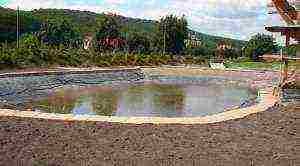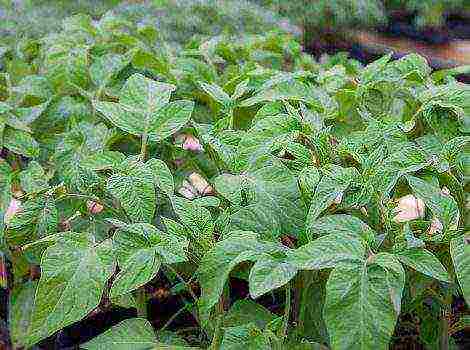Content
- 1 Growing radish (white, pink, green, black): sowing rules, care tips
- 2 How to properly plant a radish in open ground
- 3 Outdoor radish care
- 4 Harvesting radish for storage
- 5 What is the time frame for planting a radish
- 6 The most popular varieties for sowing
- 7 Root predecessors
- 8 Preparing the soil and planting seeds in open ground
- 9 Things to Consider When Growing Radish - Care Tips
- 10 Growing black radish
- 11 When to harvest black radish?
- 12 Preparing for landing
- 13 Soil preparation and sowing
- 14 Care
- 15 Problems
Since the 12th century, for Russia, radish, along with turnips and horseradish, is one of the most popular crops that is present on the table every day. This attachment to radish is understandable: it is loved not only as food, but also as a powerful medicine, thanks to the presence of mineral salts, vitamins and trace elements. And now a juicy and tasty vegetable can be bought without any problems in any supermarket. However, it is much more interesting and not difficult to grow it yourself in the country. To make sure you can do this, check out our tips and tricks for proper planting and proper outdoor care of your radish.

Growing radish (white, pink, green, black): sowing rules, care tips
In general, the rules for growing any radish are very similar, there are no fundamental differences in planting and caring for black, white or green (margelan), except perhaps, except for the timing of their sowing, taste and useful properties.
Types and varieties
- White, popular varieties: early (Delicacy, Odessa 5, Maiskaya, Sudarushka), medium (Elephant's Fang, Dragon), late (Winter round white, Autumn giant);
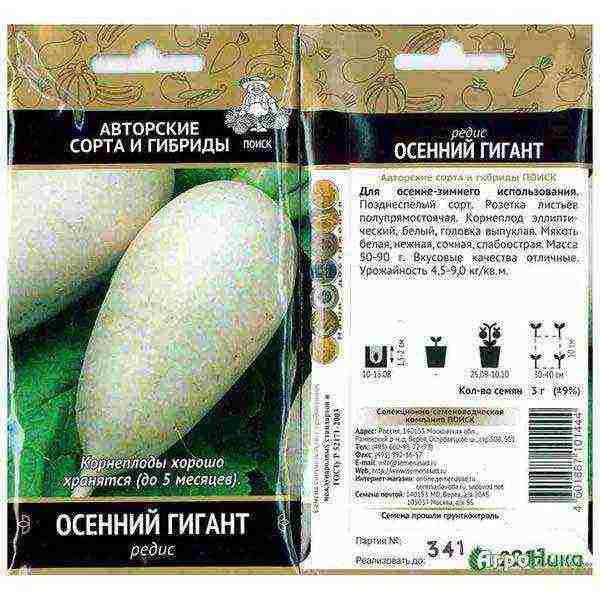
- Pink, popular variety: Crimson moon (early maturing).
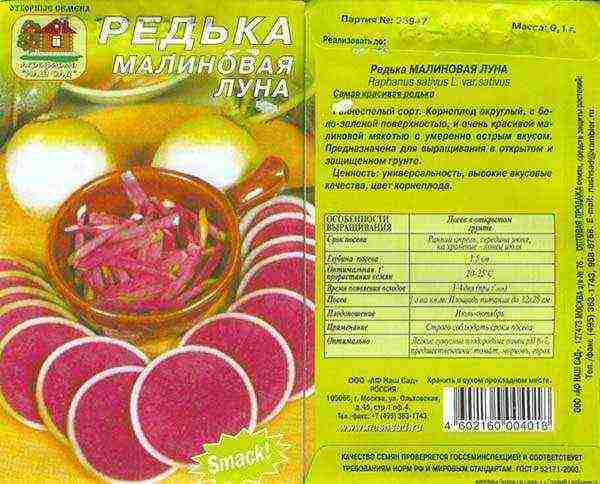
- Green (Chinese), popular varieties: Margelanskaya (mid-ripening), Green Goddess (early-ripening), Yuzhanka;
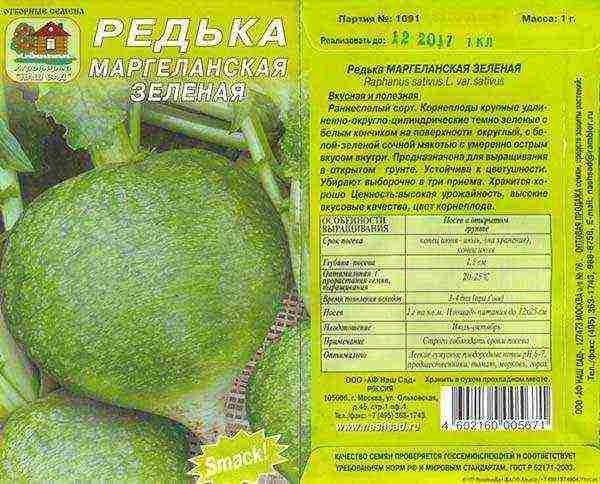
- Black, popular varieties: Winter round black, Black winter, Chernavka, Healer.

Video: planting a Margelan radish
Landing dates
The timing of sowing radish in open ground is largely determined by the vegetable variety:
- early small-fruited varieties can be sown already in March-April (if, of course, the weather allows. days;
- early ripening (summer) - in late April - early May, ripening period - 50-65 days;
- late (or they are also called autumn or winter, black) - in early or mid-July, ripening period - 90-110 days.
Although it is equally important to take into account both the climatic conditions of the region and the current weather conditions. The optimum temperature conditions for seed germination are + 20-25 degrees, but planting is also allowed at + 15-20.
Video: radish - varieties, sowing dates and care
Further, on the example of its black variety consider the basic rules for growing radish: sowing and care in the open field.
How to properly plant a radish in open ground
There are a lot of varieties of this useful root crop at the moment, but black radish, due to its useful and medicinal properties, is of particular value.
Useful properties of a root vegetable
Black radish is both delicious and healing vegetable. If you have sand in your kidneys or liver, then with the help of a radish you can significantly improve your condition. It also helps if you have a cold (such as a lingering wet cough), high cholesterol, and it also improves performance and stress tolerance during busy work schedules.
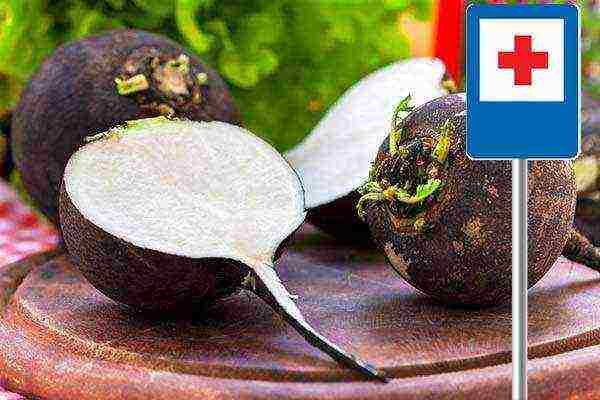
Note! You should not use radish (any) if you have peptic ulcer disease, inflammation of the gastrointestinal tract and liver, as well as heart disease.
Another advantage of planting black radish is its suitability for long-term storage.
Sowing dates
The dates for planting black radish are in the middle of summer, namely, it is advisable to plant it from the 3rd decade of June to the 3rd decade of July.
If you plant it too early, then with a long daylight hours, it can go into flowers (it will begin to shoot and throw out flower-bearing shoots) and subsequently prevent root crops. Therefore, in order to accurately wait for the ripening of the vegetable, observe the timing of its sowing.
Garden bed preparation: site selection and suitable soil
A good harvest of radish can only grow in the right spot. It is optimal to find a place that is illuminated by the sun most of the day.
As for the land, the radish grows best on fertile loamy soil, in other words, light humus soils with an acidity of 6-7 pH are suitable for it.
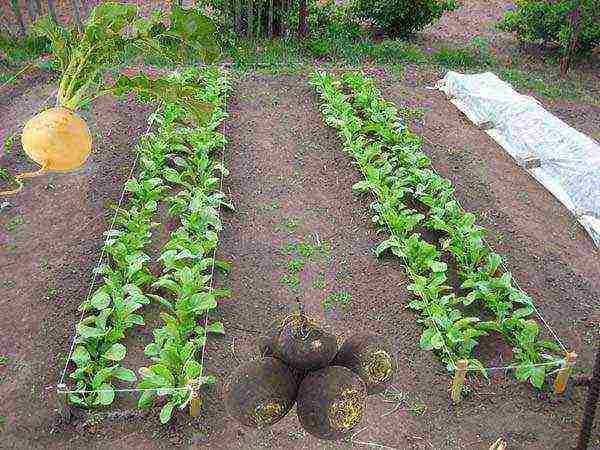
It is quite simple to prepare a garden bed for a radish: you need to thoroughly dig up the ground (to a depth of 30-35 centimeters), add a couple of buckets of excellent compost, wood ash, and then mix everything again and level the garden bed.
Next, you need to make rows for sowing radish seeds. The sowing depth of seeds should be 1.5-2 centimeters. The distance between the rows should be maintained at 20-40 centimeters. It is optimal to sow the seeds themselves at a distance of 10-15 centimeters, but if you want to get an even higher yield, then sow them closer in order to subsequently thin out and get rid of weak plants, leaving only the healthiest ones.
Many summer residents practice joint sowing of radish with potatoes, cucumbers, onions, tomatoes and even corn.
As a rule, they try to plant the radish after harvesting.garlic... The following crops will also be good predecessors: onion, tomato, cucumbers, carrot, beet and peas and other legumes.
Sowing seeds
Step-by-step instructions for sowing radish in open ground:
- Before sowing, it is advisable (but not necessary) to soak the seeds for 24 hours in a pink solution of potassium permanganate.
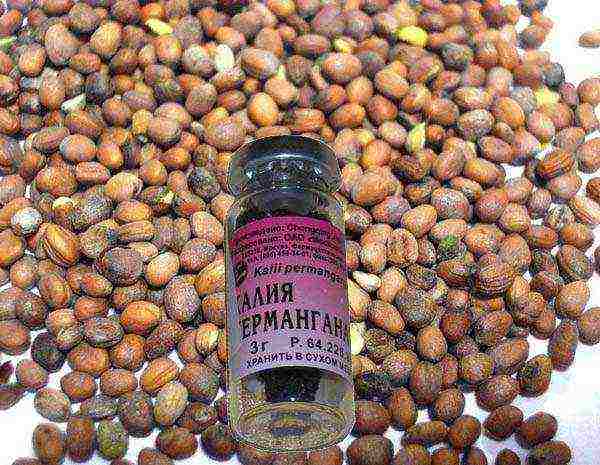
- Make grooves or planting holes with a depth of 1.5-2 centimeters every 5 centimeters (if you plan to thin out) or after 10-15 (if without thinning) at a distance of 20-30 centimeters.
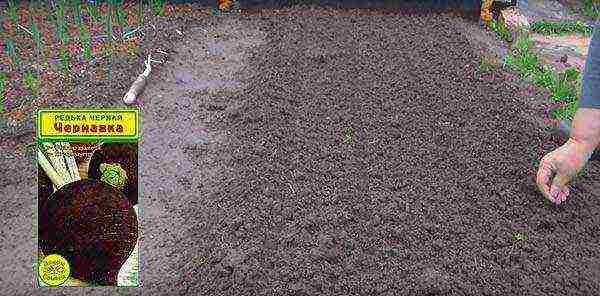
- Place seeds in grooves or holes, and then cover with soil and compact slightly.
- Water abundantly (the same can be done after stage 2) and cover with foil (optional).
- Dust with ash and / or tobacco dust from black (cruciferous) flea beetles.
Video: sowing black radish
Outdoor radish care
Despite the fact that this vegetable is considered to be quite unpretentious, some care is required to obtain a rich and tasty radish harvest.
So, in first time after sowing desirable maintain high humidity in the gardenso that the seedlings appear together. As a rule, it takes about 3-5 days, but after germination for 1-2 weeks, the garden should be kept moist. There are two ways - either constant watering, or you can cover the bed with a film that will retain moisture.
A week later, through the emergence of seedlings, the garden should be first time thin outleaving only the strongest seedlings.
Further care of the radish is quite standard: on time to water (if you forget about watering, then the root crops will grow small and bitter and will not be edible), preventing the soil from drying out, at least once a week, loosen and weed.
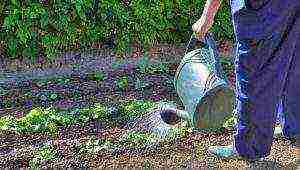
By the way! To reduce the number of watering, loosening and weeding, you can mulch the beds with peat or humus.
Also, during the summer, you need to make sure that the seedlings do not hinder each other's development. If you notice that the plantings are thickened, then you should perform one more thinning, otherwise the roots simply will not be able to ripen normally and will turn out to be small.
As for the dressing of the radish, then during the season it should be fertilized at least 2 times. The first time when 3-4 leaves appear (nitrogen fertilization), the second time - a month after the first, when the root crop begins to grow actively.

As a fertilizer, it is optimal to use herbal infusions, birch tar (protection against pests), ammonia (nitrogen). Also ammonium nitrate (1 tablespoon per 10 liters of water) is suitable for nitrogen fertilization.
Advice! It is very good to combine top dressing with watering.
Diseases and pests
Black (cruciferous) fleas are very fond of young seedlings of radish, therefore, as measures to combat these pests, the crops should be treated, more precisely, powdered with tobacco dust or wood ash.
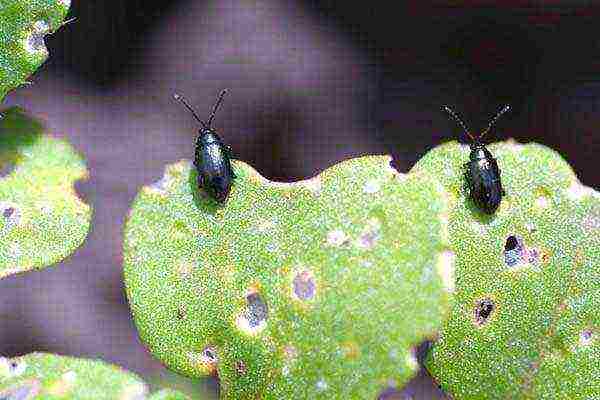
Harvesting radish for storage
If you want to store black radish for a long time, then you need to harvest and prepare it for storage according to certain rules. So, it must be collected on time in most cases before the end of October and always before the onset of frost. You need to pull out the vegetable, slightly digging in with a shovel. Next, you should get rid of the foliage, but if you are determined to store the radish for a long time (for example, all winter), then you should leave 1-2 centimeters of the foliage.
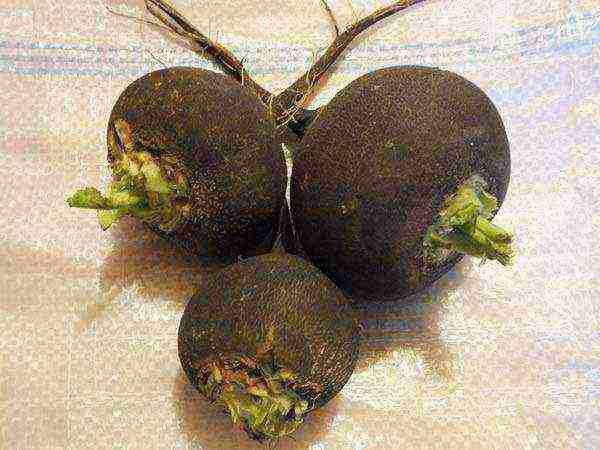
Important! If you put this root crop for long winter storage, then you cannot wash it, just shake it off of the dirt and that's it, otherwise it will rot.
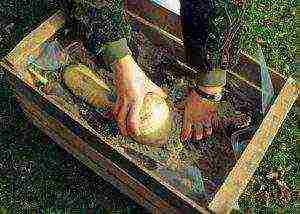
Optimally put dry root vegetables in boxes with wet sand and remove to the basement or cellar for long-term storage.
You can also store the radish in refrigerator. In this case, the tops must be cut off completely, rinsed thoroughly, and then also shortened the tail, leaving 4-5 centimeters. Next, the roots should be processed in a slightly green solution of brilliant green, immersed in it for 1-2 minutes. When the vegetables are dry, they must be put in bags and put in the refrigerator.
Video: black radish - from sowing to harvest
Thus, even a novice gardener can grow a radish (no matter what kind, white, Margelan or black). You just need to choose the optimal time, properly prepare the soil and sow the seeds, and then provide high-quality care for the root crop until it is fully ripe.
Video: everything about planting radish seeds, care, growing and its proper storage
Radish is one of a number of unique vegetables. It is rich in vitamins (A, B9, K, C), trace elements, organic acids, essential oils, amino acids, vegetable fats, carbohydrates, proteins. Radish contains phytoncides - substances that inhibit the growth or kill bacteria, making it a natural antibiotic with the broadest spectrum of action, enhances immunity, improves metabolism, digestion, and removes fluid from the body. A number of useful qualities of a vegetable can be continued, but this is enough to make you want to plant and grow a root crop in your backyard or cottage.
What is the time frame for planting a radish
It is for this vegetable that planting dates are of great importance. First you need to decide for what purposes you are going to plant and grow the radish - for long-term storage and use in winter or for eating in spring and summer.
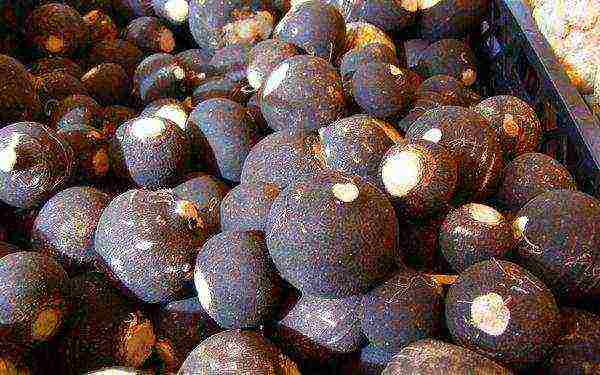 Before planting, you need to decide on the storage period for future root crops
Before planting, you need to decide on the storage period for future root crops
Early small-fruited varieties are sown in March. Fruits ripen in 40-45 days, slightly spicy, juicy - a rich source of early vitamins.
Summer varieties are early ripening, ripen in 55-60 days, so the optimal planting time is the end of April, beginning of May. The radish is not afraid of low temperatures, gives amicable shoots even at t +3 - 5 degrees.
Winter mid-season varieties intended for long-term storage ripen in 100-110 days. In order to have time to harvest on time, in central Russia, the Moscow region, in Siberia, you need to plant radish in late June - early July (the most extreme dates are the first decade of July).
Winter early ripening varieties of root crops are sown in late July - early August.
The radish is sown in open ground with seeds: in the middle of summer it sprouts rather quickly, in early spring it is not afraid of frost, therefore there is no need to grow seedlings.
In addition, some gardeners on the forums express the opinion that when transplanting seedlings, the root can be damaged and the root crop will bloom.
The most important condition for proper growth is short daylight hours... With a long daylight hours, the vegetable gives off arrows, blooms, becomes unfit for food. That is why radish is sown in early spring or in the second half of summer, when daylight hours become shorter.
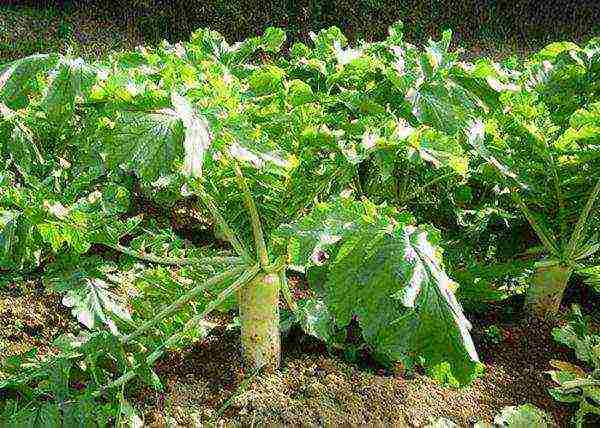 The main criterion for the successful growth of a radish is a short daylight hours.
The main criterion for the successful growth of a radish is a short daylight hours.
The most popular varieties for sowing
In order to enjoy the taste of a healthy, juicy root crop all year round, several varieties are sown with different ripening periods.
The most useful and rich in vitamins and minerals is black radish... It tastes sharper and in all respects it is significantly ahead of its "colored relatives". Consider a few of the most popular and high-quality representatives.
- Round black... The variety is mid-season, ripening time - 80 days, has the best taste and medicinal qualities, high-yielding - 7.5 kg / sq. m, suitable for long-term storage. The root crop is rounded, weight - from 250 to 500 g, the peel is black, the flesh is white, juicy, the taste is bright, spicy.
- Winter long black... Fruits are elongated, black. The pulp is white, crispy, juicy. Even after long-term storage, it does not lose its useful properties.
- Margelan (Chinese)... Fruits are green with light green pulp. This radish is not as healthy as black radish, but you can eat much more of it - it tastes very juicy, slightly spicy, without bitterness. Sown in summer, until July 5-10, as the variety is late-ripening, high-yielding, has excellent keeping quality, right up to spring.
- May early... An early ripening summer variety with juicy, tender pulp, semi-spicy to the taste, does not darken for a long time.
- Winter white... Medium pungent taste, dense tasty pulp, high-yielding, retains its presentation for a long time.
In addition to these, there are many more popular varieties: Odessa 5, Daikon, Summer Round White, Olive, Elephant Fang, etc.
Root predecessors
The vegetable belongs to the cruciferous family and should not be grown after cabbage, radish, turnip.
The rest of the horticultural crops are good predecessors: potatoes, tomatoes, cucumbers, carrots, beans. Winter radish varieties can be planted in the garden after harvesting green onions, lettuce, green peas, beans.
Preparing the soil and planting seeds in open ground
Loves well-lit, sunny places, moist and loose, deeply dug soil... For spring planting, the beds must be prepared in the fall: add humus, mineral fertilizers, and ash in acidic soils.
Seed preparation
If you want to get a high-quality harvest, roots of the same size, seeds are a must calibrate - Remove small, irregular, empty or half-sized grains, leaving only large healthy grains of the same size.
 The first step is to calibrate the radish seeds.
The first step is to calibrate the radish seeds.
To obtain friendly shoots, you can (but not necessarily) process the seeds humate or growth stimulant before planting. Treated seeds go less into the arrow, bloom.
How to sow
Before planting, the earth is dug to a depth of 30-35 cm, the surface is leveled, grooves are made deep 2 cm, between the rows - 30 cm... Seeds are introduced into the grooves, covered with earth and the bed is well watered.
Before seed germination, the soil must be kept moist. As soon as the first shoots appear, they are thinned out, leaving the strongest ones. Next time, it is necessary to thin out the shoots no later than a month later to avoid thickening. The distance between the remaining radish sprouts should be 15 cm.
Further care consists in the constant maintenance of moisture and loosening of row spacings - the radish loves oxygenated soils.
Things to Consider When Growing Radish - Care Tips
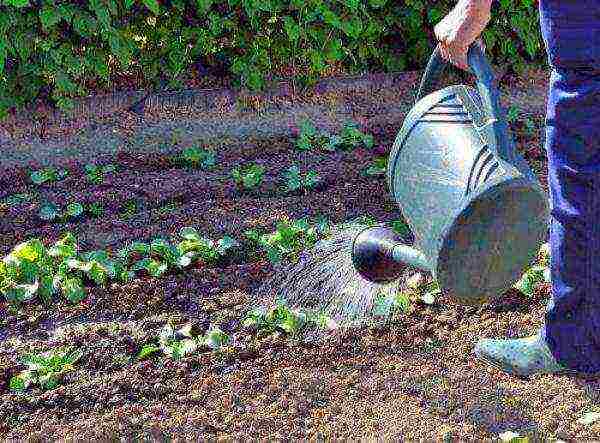 After planting the radish, the soil should never dry out.
After planting the radish, the soil should never dry out.
To avoid common mistakes, to get tasty, juicy roots with dense pulp, you need to follow some rules:
- thickening must not be allowed, thin out in the phase of 2-3 leaves, then after 15-20 days;
- watering should be frequent, the soil should not dry out in any case;
- there is never enough ash for a radish - she loves ash, it can be applied before planting, at the stage of 3-4 leaves, and during the appearance of cruciferous flea beetles, it can be scattered over the entire surface of the bed, even on the leaves;
- fertilization with boron, magnesium, table salt will have a good effect on the quality of the fruits - they will increase the sugar content, improve the growth of plants.
Radish is a unique and useful product that must be included in the diet of a healthy diet. A good harvest from the garden will help protect you from colds and other diseases throughout the winter. Cultivation is possible in almost all regions, even beyond the Urals, the main thing is to correctly sow and follow the rules of care.
 Black radish is not a variety. It is a variety with early, medium and late sowing varieties. The features that distinguish the species are the dark rind and the greatest sharpness of the pulp. The cultivation of black radish in Russia is carried out in the XII century. It was used as an extremely useful and medicinal vegetable. Culture came from the East and fell in love with the people for its useful properties and productivity.
Black radish is not a variety. It is a variety with early, medium and late sowing varieties. The features that distinguish the species are the dark rind and the greatest sharpness of the pulp. The cultivation of black radish in Russia is carried out in the XII century. It was used as an extremely useful and medicinal vegetable. Culture came from the East and fell in love with the people for its useful properties and productivity.
Growing black radish
 Among the people, varieties of medium and late ripening with black peel and white pulp are very famous. It is imperative to maintain the timing of sowing radish seeds, since the length of the day is of great importance for the development of plants. Distinguish:
Among the people, varieties of medium and late ripening with black peel and white pulp are very famous. It is imperative to maintain the timing of sowing radish seeds, since the length of the day is of great importance for the development of plants. Distinguish:
- early small-fruited varieties, sown in March;
- early ripening varieties, sown in late April, early May;
- mid-season varieties sown at the zenith of summer;
- late varieties, sown in mid-July.
The recommended planting dates for black radish, planting and care techniques are always on the seed packages, they must be adhered to. Varietal characteristics allow, with proper culture management, to avoid shooting or cracking of root crops. This is especially important for a product intended for winter storage. All varieties of black radish have a two-year growing season, which means that you can get seeds only in the second year.
Usually, black radish is planted on the bed that has been vacated after early salads or onions when the recommended period comes up. Before that, the soil is well dug up and filled with fertilizer. Experienced vegetable growers believe that radish will be more juicy if grown on mineral fertilizers without adding compost. At the same time, the land should be loose and fertile.
The garden bed is dug up with the addition of a glass of ash, three tablespoons of superphosphate, and one each of potassium chloride and urea. The earth is dug to a depth of 35 cm, leveled and grooves or holes are made with a distance between plants of 15 cm and between rows of 30. Seeds are sown at a depth of about three cm, several times into the nest, so that later the strongest seedling will be left. During the growing season, the plants are thinned twice more in order to exclude the thickening of the plants.
The land at the planting site should always be wet and pubescent with ash, since it is at this time that cruciferous fleas are raging. Seedlings will appear in a few days, and it will be an important task to protect them from the pest. Further care will include the following activities:
- constant content of plants in the moist layer of the earth;
- removal of weak plants;
- loosen the soil, avoiding the formation of a crust;
- protect sheets from pest infestation;
- harvest before the onset of frost.
Keeping the soil moist removes the question of why the radish turns into color. In addition, hard clay soil can affect the quality of root crops.In such conditions, the radish grows clumsy and cracks. Therefore, the choice of planting site and soil quality will be the key to a good harvest. It is impossible to use fresh organic fertilizers as soil filling and top dressing.
Experienced gardeners advise to swing the root crop a little during the growing process in order to remove the side roots. The plant, feeding only through the taproot, grows medium-sized and juicy.
Radish has a lot of pests. How to grow a commercial black radish? Do not allow carrot fly or cruciferous flea larvae to spoil the root crop. Through the damaged skin, bacteria and spores of putrefactive fungi penetrate into the pulp and such a fruit will not be stored. In addition, the radish can be damaged by the cabbage leaf beetle, aphids, slugs, and rape flower beetle.
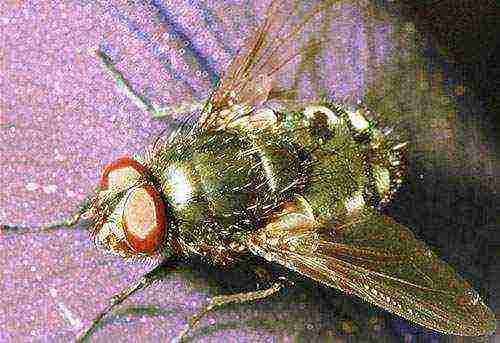 Biologicals and enzymes can be used to control pests. For example, lipocide or fitoverm. They decompose quickly and do not affect the quality of root crops. The thickened plantings are most damaged. Therefore, summer residents often use the edges of the beds for sowing and growing black radish, arranging rare holes around the perimeter of potato, onion, cucumber plantings in order to exclude common pests.
Biologicals and enzymes can be used to control pests. For example, lipocide or fitoverm. They decompose quickly and do not affect the quality of root crops. The thickened plantings are most damaged. Therefore, summer residents often use the edges of the beds for sowing and growing black radish, arranging rare holes around the perimeter of potato, onion, cucumber plantings in order to exclude common pests.
When to harvest black radish?
 For storage, black radish of late and medium varieties is grown. These varieties include Skvirskaya black, Winter round black; Gaivoronskaya. The varieties can be stored for up to 200 days. To do this, it is necessary to remove healthy roots before the first frost, since frozen roots are not stored.
For storage, black radish of late and medium varieties is grown. These varieties include Skvirskaya black, Winter round black; Gaivoronskaya. The varieties can be stored for up to 200 days. To do this, it is necessary to remove healthy roots before the first frost, since frozen roots are not stored.
Late-ripening Gaivoronskaya radish gets a marketable root crop 110-120 days after sowing. A medium-ripening Black Winter Radish is ready for harvesting in 80 days. When to harvest black radish depends on the selected variety.
For storage, the tops are removed from the root crops, they are slightly dried in a dark cool room and stored in the cellar. Radish contains mineral salts, trace elements and essential oils. A very useful product is also a remedy in traditional medicine.
In ancient Greece, black radish was considered the queen of vegetables, a golden copy was created and presented as a gift to Apollo. And in Egypt, this vegetable was considered the food of slaves.
However, millennia have passed, and radish continues to be a necessary vegetable on all continents. It is important to know that this product is contraindicated for those who have problems with diseases of internal organs in the acute stage.
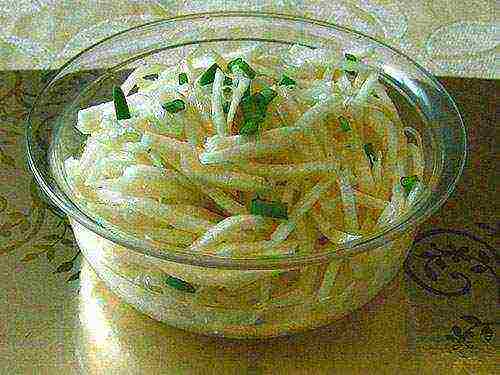 Dishes with the participation of black radish deliver potassium to the body, which stimulates life processes. It is a storehouse of mineral salts, vitamins and trace elements. However, the mustard oil and esters present in radish in high concentration irritate the kidneys, liver and gastrointestinal tract. For a healthy person, this action only stimulates the organs to work. Radish gruel can serve as a hair mask and compress on sore joints. Therefore, radish should be included in a healthy diet.
Dishes with the participation of black radish deliver potassium to the body, which stimulates life processes. It is a storehouse of mineral salts, vitamins and trace elements. However, the mustard oil and esters present in radish in high concentration irritate the kidneys, liver and gastrointestinal tract. For a healthy person, this action only stimulates the organs to work. Radish gruel can serve as a hair mask and compress on sore joints. Therefore, radish should be included in a healthy diet.
All about radish - video
Radish has always been considered one of the most important food items. It contains a huge amount of vital minerals, vitamins, in addition, it contains sugar and protein. It has been known since ancient times. Even the builders of ancient Egypt ate the root crop. Although it is not harmful at all, you still need to know the basic principles of its cultivation.
Interesting! The fruits of some varieties of radish reach a weight of 1 kg. There are a lot of varieties of culture, but their cultivation is not much different. The radish rhizome has a different shape and color.
Preparing for landing
First of all, you need to decide on the purpose of planting a root crop.
- Annual varieties are early.
- Two-year-olds - intended for storage in the winter.
The division into these two types is conditional.
Seeds must be disinfected and calibrated before sowing. To do this, they are soaked in salted water (1 tablespoon per liter of liquid).The seeds that have risen are removed. The day before disembarkation, it is recommended to soak them for 15-25 minutes in a weak solution of potassium permanganate.
Soil preparation and sowing
In order for the radish to grow large and tasty, the soil should be prepared in the fall. She prefers well-lit places. The soil should be loose, moist and well dug up. You also need to add mineral and organic fertilizers (nitrogen, phosphorus, potassium).
Good predecessors in the garden:
- peas;
- tomatoes;
- cucumbers.
But representatives of the cabbage family are categorically not suitable. If you want to get a big harvest, you should not plant a root crop after them.
Before planting the seeds, the soil is well dug to a depth of 35-40 cm. Shallow grooves are carefully made with sticks, about 2 cm, and the row spacing is 30 cm. Seeds are placed in them and buried. Be sure to water them from a watering can after sowing.
Until the seeds have sprouted, the soil should be moist. After the emergence of all shoots, the plants should be thinned, leaving only the strongest. The procedure is repeated about a month later so that they do not grow too densely and do not interfere with each other. The distance between the roots must be at least 15 cm.
Planting radish begins in early May. Overseeding can be done every 20-25 days. In the event that already germinated seeds were used, the grooves must be well moistened.
After planting seeds in the ground, the garden bed should be mulched. Peat and humus are suitable for this purpose. They are great for keeping the soil moist. As a rule, seedlings appear in 3-4 days.
The radish needs space, which gives it a nutritional area and form larger fruits. Some gardeners use the square-nest method of sowing: 2-3 seeds are placed in each hole with an interval of 15 cm. Excess plants are removed after germination.
Care
It is impossible for the radish to grow too close to each other, it is imperative to thin out after the appearance of the first 2 true leaves at a distance of 5-6 cm between plants, again - from 10 cm.
In thickened plantings, the risk of obtaining a large number of flowering shoots increases. These root vegetables are not suitable for human consumption.
Watering should be done often, preventing the soil from drying out, since with a lack of moisture, vegetables will taste bitter and small.
Important! After a drought, do not pour water over the radish, as they can crack. It is desirable that the ground is constantly slightly damp.
Be sure to add ash to the soil. Especially when fleas appear on the leaves.
You need to feed the plants after the first shoots appear. For this, both mineral and organic fertilizers are suitable.
Problems
The main difficulty that a gardener may encounter when growing radish is shooting. The thing is, she doesn't like long and hot days! These conditions provoke flowering. Another reason for flowering is early planting. To prevent the root crop from blooming, it must be planted in June (recommendation for central Russia).

